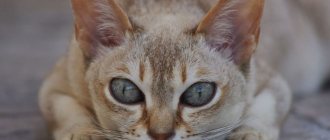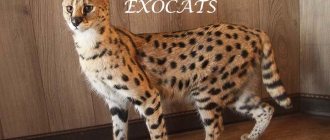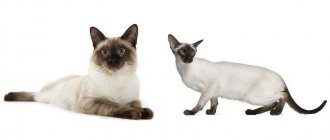Origin of the breed
The homeland of Thai cats, as the name suggests, is the kingdom of Thailand. The most ancient images of these animals appeared in the 14th century. They are considered the ancestors of modern Siamese, which were called old-type. The distinction between these breeds was achieved through long selective breeding work. Old-type individuals arrived on the European continent in the 19th century, and in the USA at the beginning of the 20th. Breeders received cats that only vaguely resemble their ancestors. Standards for Thai cats were formulated in 1990; Siamese standards received such criteria 30 years earlier.
The legend of the appearance of the Thais
There are several versions of the appearance of the Thai cat breed. One of them says that the Thais have in their roots 11 different breeds of cats that lived in the territory of the state of Siam (modern Thailand) in ancient times. In 1880, the British ambassador brought a Tiger kitten to Europe from his trip to Siam. Soon, Europe and America were overwhelmed with interest in these beautiful and wayward felines.
Tigers appeared in our country in the 18th century. These cats were liked by the elite class and they began to be successfully bred. Proof of their popularity are considered images in paintings painted during this period (photography did not exist then). The Thai breed was brought to Russia in 1960. These individuals looked like Siamese.
Interesting fact! Another name for these cats in pre-revolutionary Russia was Chinese. Society mistakenly believed that China was the birthplace of animals. And in England they were nicknamed Apple heads for their unusual head shape.
Description of Thai cats
Thai cats have similar features to their direct descendants, the Siamese. They can be distinguished by a number of characteristic features:
- Medium sized body, stocky. Weight varies between three and five kilograms.
- A round head, shaped like an apple with an extended muzzle.
- Slanted eyes, usually blue. The shape is almond shaped.
- The ears are smaller than those of real Siamese. Located on the sides of the head and slightly rounded.
- The muscular neck is of medium length, but can be short.
- The size of the tail is proportional to the body.
- The animal's legs are strong, with rounded paws.
- The coat is short, without undercoat. The fit to the body is less pronounced than in Siamese.
Many inexperienced people confuse Thais with Siamese cats, but their differences can be seen with the naked eye. Thais look rounder and fluffier than Siamese.
Breed standards and defects
The description of the Thai cat includes the standards by which the class of the animal is assessed, and defects of the breed, due to which the individual may not be allowed for exhibitions or breeding.
In kittens up to one year old, it is considered normal for the so-called mask to be unpainted on the face - a rounded mark of a darker coat tone. There may be stripes if the animal is tabby or point. Eyes that are too round and not almond-shaped are penalized. Undesirable appearance features are considered:
- extremely oriental eyes;
- sharp or, conversely, blunt head shape;
- ears are large, small, located low on the head;
- compact tube-shaped body;
- flaccid tail;
- presence of excessive undercoat;
- the presence of pale markings on the body, unless we are talking about agouti color.
You can read about the Burmese cat breed and its colors here.
There are signs by which an animal may be disqualified and not be allowed for further breeding. These signs are:
- pronounced tail defects;
- slanted eyes;
- protuberance on the chest;
- aggression;
- extra toes;
- complete or partial blindness;
- the presence of bone pathologies.
These criteria are a defect for this Thai breed. If there is at least one of these points, the individual cannot be admitted to exhibitions, competitions, and other international events in the field of felinology.
Thai cat color.
Brief description of the breed
The breed is relatively new. Its standards were approved in Germany in 1990. The animal is independent and active, gets along well with children.
Description of the breed:
- Proportional body.
- Flexible body.
- The weight of females is up to 4 kg, males – up to 6 kg.
- The head is teardrop-shaped.
- The muzzle is of medium length and has rounded outlines.
- The nose is of medium length, straight.
- The ears are set wide apart and spread to the sides.
- The eyes are shaped like apricot kernels and their color varies from bright azure to blue.
- The tail is wide at the base, tapers towards the tip, and is of medium length.
- The chest is wide.
- The neck is of medium length, strong.
- The legs are muscular.
- The coat is thin, short, and has an undercoat.
- There are dark markings on the bridge of the nose, at the ends of the paws and on the tail.
Thai cats resemble Siamese cats. The difference is in a more massive body and grace. On average, Thai cats live 10-14 years . There are known representatives of the breed who lived up to 28 years.
By nature, cats are flexible, inquisitive, active, and affectionate. They are easy to train to follow certain commands. Thai representatives are good mouse catchers.
Colors of Thai cats
The color of the animal should be contrasting. The lighter the body of the animal and the darker the tail, the better. At birth, the kitten is white, the final color is acquired only at three months and throughout life the pigment only becomes darker. Colors that are regulated by strict international rules:
- Seal point. The color of the animal can range from light brown to light cream. The Thai seal point cat has a tail, paws and muzzle of dark, contrasting colors relative to the overall body color.
- Blue point. It is a bluish-white coat color. There are gray-blue individuals. The eyes of such animals have especially bright eyes.
- Chocolate point. Ivory animal background with chocolate or café au lait markings.
- Lilac point. This is a gray-purple coat color on the paws and tail, the fur coat is the color of magnolia.
- Tabby. Sometimes this color is called tabby point. In this case, there are stripes of a certain color on the animal's body.
- Red point. Individuals with a red or red color.
The contrast to the main color makes the animal’s appearance more expressive, bright and memorable. The animal's color may change over time; young kittens are lighter than their more mature counterparts.
Seal point.
Blue point.
Chocolate point.
Lilac point.
Red point.
Tabby.
Rare options
The following colors are considered rare for the Thai breed:
- Cinnamon Point. There are cinnamon colored markings on the body. Individuals with contrasting warm colors or cool light tones look very impressive.
- Caramel. Warm delicate caramel color. The presence of stripes is considered undesirable, but not a critical drawback.
- Fawn point. Such animals have pastel pink spots on their body, and the body itself is painted light lilac, reminiscent of watercolor.
- Gray-brown point. Very contrasting color type. There are clear brown and gray markings on a white background.
Defects for these colors are dark fur on the belly and lack of point color. The eyes must be strictly blue, even if there are only inclusions on the cornea of a different shade. The most expensive colors are tortoiseshell, regardless of its range.
Cinnamon Point.
Caramel
Fawn point
Gray-brown point
Unrecognized colors
Now felinologists are working in the field of various tabby colors, new colors will be obtained in this direction. Epricot points and silver have already been demonstrated, but so far they have not received their official recognition from international organizations.
Types of purchase
Depending on age, you can buy:
- Three months old.
- Four months old.
- 5 month old.
- A six-month-old kitten.
The kitten is taken from its mother no earlier than at the 12th week of life. The older the kitten, the cheaper it will cost.
Depending on the color, you can buy a Thai cat of this type:
- Chocolate point. Ivory in color, the face, paws, tail and ears have light brown markings.
- Tabby point. The body is white, and the paws, muzzle and ears are striped.
- Blue point. The body is bluish in color, the tail, limbs, muzzle, and ears are dark gray.
- Lilac point. Cool shades are combined with lilac.
- Cream point. Characterized by a cream color and dark markings.
- Seal point. The limbs and muzzle are dark brown. The markings on the face are almost black.
- Tortie point. Tortoiseshell body color is combined with gray, red or cream shades.
- Red point. There are red markings on the limbs, the body itself is white.
- Fawn point. The cats are white and have grayish-bluish markings on their paws, face and tail.
Depending on the class, you can buy a kitten:
- Pet (for keeping at home as a pet).
- Breed (for breeding).
- Show (for taking part in exhibitions).
Show-class representatives are more expensive, non-show class ones are cheaper.
Depending on the place of purchase:
- From the breeder.
- At the pet market.
- In the nursery.
- According to the advertisement.
From professional breeders and nurseries, Thai cats are more expensive than at a pet market or advertised.
Thai character
The Thai breed is easy to train; these cats like to bring their owner a ball, slippers and run after them when ordered. Thai pets will happily greet their owner from work and purr happily for a long time. Such cats are considered sociable and are uncomfortable being alone. Thais are considered smart cats. This is expressed in cleanliness, communication skills, and the ability to train. One of the traits of this particular breed is the ability to understand people well. They will immediately determine who is in charge in the family and will count the “leader” among their favorites. It is worth remembering that these felines do not like to sleep all day, they are restless and playful - they are unlikely to be suitable for the company of an elderly person.
These cats are considered talkative and love to chat with their owner and family members. At the same time, the animal has a rich sound range - from purring to loud meowing. All owners note the high degree of curiosity of these animals; all new objects and objects in the apartment will be explored by them. Often for this reason, Thais get injured when they climb into places where their presence is completely undesirable.
Who are Thai cats suitable for?
The Thai breed will be a great find for single people and for large families with children and other animals. The main requirement is to give your pet enough time and attention. This animal will feel bad in a family of workaholics who spend a lot of time at work and not at home. Communication with people is important to them. It will be especially difficult if the owner often goes on business trips and the animal will have to be placed with his friends or relatives for a while. You should not get a cat if there are small animals in the apartment that could become easy prey for the cat.
Gray Thai cat.
Child Compatible
The Thai breed is distinguished by its friendliness, including towards children. You can leave your child with them without fear of bites or scratches. In situations where a child can hurt an animal, it will prefer to avoid the conflict and get into a fight.
Raising a pet
Thanks to their developed intelligence, these cats are trainable and even more amenable to education. To teach a cat simple commands and a tray, you just need to show the cat its place, the animal will quickly understand. As a rule, there are no problems with a cat going to the toilet in places that are not intended for this.
Thai kitten.
Diet of Thai cats
Premium food, balanced in composition, is perfect for this breed. Before purchasing, you should carefully read its composition and refuse to purchase feed that contains iodine. It causes the fur of animals to darken. As natural food you can use:
- boiled vegetables;
- porridges with a high content of meat or offal;
- offal - liver, kidneys, tongue, lungs and other organs;
- fermented milk products with reduced fat content;
- River fish;
- lean meats.
You should not feed your Thai cat sea fish or any seafood. They have a high iodine content. In addition to proper nutrition, it is important to provide the animal with clean water. For pregnant and lactating cats, the portion of food should be increased, and the frequency of feeding should also increase. It is necessary to use special vitamin and mineral supplements.
Health and diseases of the Thai cat
The history of the Thai breed goes back several centuries. During this time, they developed strong immunity and health. Visits to the veterinarian, with proper care and nutrition, are infrequent. Despite this, the following diseases of Thai cats are more common than in other breeds:
- diabetes;
- malignant tumors of the mammary glands in females;
- lung tumors;
- hydrocephalus.
A cat of this breed has a good chance of living up to 25 years, and even 30. On average, their duration is 10-15 years.
Possible problems
Strong health and immunity does not mean that an animal does not need to be vaccinated. It is also a mistake to think that Thais generally have no problems other than hereditary ones with these animals. Improper nutrition can cause a number of diseases of the liver, digestive system, kidneys, and heart.
Statistics show that individuals of this breed encounter typical diseases with the same frequency as all other cat breeds.
Vaccinations
A Thai cat must have the same vaccinations as all other cats. Mandatory vaccinations are:
- calicivirus;
- rhinotracheitis;
- panleukopenia;
- chlamydia;
- rabies vaccination;
- leukemia virus;
- immunodeficiency;
- bronchopneumonia;
- infectious peritonitis;
- dermatophytosis.
The first vaccination is given at 8-9 weeks, and then repeated every 1-3 years, depending on the disease. Additional vaccinations are determined directly by the doctor himself.
Description and breed standard
All representatives of the Thai breed are beautiful and graceful. They are quite miniature and have good muscles. A Thai breed cat weighs on average 5–6 kilograms; cats are even smaller and are distinguished by their special grace. What types of standards apply to furry cats from Thailand:
- The head is round in shape. Drop-shaped or apple-shaped. There should be no sharp or sharp features.
- The muzzle is of medium length. The appearance is round.
- Most representatives of the Thai breed have blue eyes. Externally, the visual organ is almond-shaped, widely spaced.
- The characteristics of the breed are a proportionally developed body with well-defined muscles.
- The tail is neat, without creases, tapers towards the end and is not pointed.
- Purebred can also be determined by the animal’s paws. They are sturdy with soft, round pads.
- The Thai cat or female cat comes in a variety of colors from cream to pale blue. A distinctive feature remains dark spots on the face, limbs and ears.
Colors and coat of the Thai cat
The coat of Thai cats is silky, fine in texture with a medium-developed undercoat.
The most common color type is seal point. Fawn color, distinctive spots are dark, sometimes black. What other colors are there:
- Blue Point - deep gray with almost blue markings. Blue's nose, whiskers and pads are usually ashy.
- Chocolate Point - the fur color of the furry representatives is closer to white. A white cat has dark brown or milky brown markings.
- Lilac Point - the fur of Thai cats of this type has a crystal white hue, the markings appear dark purple.
- Red point is a cream-colored dog with red markings on the legs, ears and face.
- Tabby point - the tabby color is distinguished by the presence of stripes on the pet's tail, ears and paws. There are different subspecies of this color, seal tabby point has black stripes, blue tabby point has bluish-gray stripes. Seal point tabby cats appeared in Thailand relatively recently.
- The tortie color name refers to the tortoiseshell pattern.
Personality of the Thai cat
This is the smartest breed of the cat family. They not only catch mice, but are also trainable, active in play, and very affectionate.
Thai cats are very devoted to their owner, they patiently wait for him to return after work and are sincerely glad to see any kind of affection.
Many of those who own these cats said that they are good nannies. Thais are patient with children; they will never allow themselves to show aggression towards a child, even if he makes the cat uncomfortable.
Another side of the Thai breed's character is curiosity. They constantly strive to check every corner of the house and get into every package, which is why they often cause chaos. They love to play with their owner. In order for an animal to realize its energy, it must always have a lot of toys.
Features of care
Thais do not require special care. They are not picky eaters and are able to take care of themselves. Their fur does not get tangled, of course, if they do not run through the bushes. The animal does not shed much, just combing the coat during the molting period will be enough and there will be no problems with the fur in the house.
It is not advisable for a cat to carry out water treatments; like most pets, they do not like water.
Once a month, you should clean your pet’s ears to remove wax and other contaminants.
Health and life expectancy
Thais are a strong breed, they rarely get sick, so frequent visits to the veterinarian do not threaten the owners. However, do not forget about the necessary vaccinations and immunizations. Vaccinations for kittens begin at 2–3 months of age and then according to the established schedule. What diseases can appear in this breed:
- heart disease;
- cancer;
- tumor of the mammary glands - many females are susceptible to this disease;
- Diabetes mellitus is not a rare disease among Thai cats.
To maintain your pet’s health, do not forget about preventive examinations.
How long do Thais live? At home, representatives of this breed live up to 12–15 years. There are representatives who lived 25–28 years. And even at such an old age they are able to remain playful and cheerful.
What to feed a Thai cat
When selecting a diet, you can buy special food for your pet, according to the breed. However, Thais will not refuse a piece of meat, milk, fish, and sometimes they will gladly ask the owner for a melon or cucumber.
In any case, it is worth remembering that food should be fresh and balanced. Do not overfeed the animal. What may be included in the meal:
- beef meat;
- egg;
- chicken;
- low fat fermented milk products.
Fresh fruits and vegetables are also necessary for the animal. You can chop them and mix them with pieces of meat. Most of all they love meat products.
Breeding
Pregnancy before reaching one year of age threatens weak offspring and a threat to the health of the mother cat. The best option for breeding remains 1.5 years.
An adult cat prefers to meet his chosen one on his territory. Usually 3-5 days are enough for a cat to become pregnant.
You should choose a partner for your pet carefully, then the kittens will be born healthy and strong.
How to choose a kitten
When choosing a kitten, you should pay attention to several nuances:
- The acromelanic color type should not have white spots. It is necessary to carefully examine the kitten in the nursery before taking it home.
- The tail should be smooth and free of creases and deformations.
- The kitten should not have strabismus.
At three months of age, the kitten should already have all the necessary vaccinations, as indicated by the marks in its passport. Ears and eyes should be clean, without discharge or souring. The kitten must have good mobility, be playful and active. Weight standards for kittens by age are presented below.
Table of weight norms for Thai kittens by month.
Material on the topic: all about the character and habits of Maine Coons.
How much does a Thai cat cost?
The Thai breed is not rare, therefore, the prices for such kittens are not exorbitant. You can buy a kitten without a metric or pedigree for about 5,000 rubles. The cost of a purebred Thai, with all the necessary documents, ranges from 15 to 20 thousand rubles.
How to name a kitten
You need to choose a nickname for your pet based on its individual differences in character, color, habits, and appearance history. The name should correspond to a specific animal and characterize it as much as possible, but the name should not be too complex, it should be understandable to the people around him. The table below shows popular nicknames for cats and cats.
Names for cats and cats.
Cost of a Thai breed kitten
On average, according to statistics, a Thai cat costs from 5,000 to 25,000 rubles. Until the age of 12-18 weeks, a Thai kitten should live near its mother. The Thai mother cat feeds and cares for the cub, providing it with everything necessary for full growth and development. While staying near its mother, a small animal learns many independent living skills - nutrition, toileting, play elements, hygiene procedures, and so on.
© shutterstock
The price of a kitten of the Thai breed is classified as follows::
- a kitten without a pedigree will cost from 1000 to 3000 rubles;
- a kitten that does not have documents, but comes from purebred parents, will cost the buyer from 3,000 to 5,000 rubles;
- the presence of metrics, an impeccable exterior and a recorded pedigree increase the cost level of a representative of the Thai breed several times - from 10,000 to 25,000 rubles.
While the pet is in the kennel, he receives the first mandatory vaccinations. Animals that are one year old can undergo spay or neuter surgery. An adult Thai cat is a good option for purchasing, as it can be immediately taken to a new home, where it can easily and quickly adapt.
Interesting facts about the breed
There are several interesting facts about Thai cats:
- Such cats are distinguished by their talkativeness and even artistry. They express their mood using intonation. Depending on the situation, they change the timbre and volume of their voice.
- At birth, Thais are white, but with age they develop darkening on their ears, tail, and paws.
- The Thai breed gave rise to the Burmese and Balinese breeds.
The Thai cat will decorate any home and become a true loyal friend for its owners.
What determines the cost of a Thai cat?
The price for kittens of the Thai breed depends on many factors - age and pedigree, achievements and marks at exhibitions and championships, gender and appearance, availability of vaccination and quality of kitten care, level, fame and location of the nursery, relative to Moscow.
Only those cats that have an official certificate are considered true carriers of the Thai breed. All others are considered only superficially similar to this breed.
Advantages and disadvantages
Like any breed, Thais have their own pros and cons. The advantages of these cats include:
- sociability;
- excellent communication skills with people and other animals;
- devotion;
- friendliness and lack of aggression;
- developed mind;
- good manners and ability to train.
But there are several disadvantages. These include an increased sense of revenge - a Thai cat will not tolerate bad treatment at all. These animals can also be called overly stubborn. If a kitten wants something, he will make every effort to achieve it.











